Ryobi P501G Owner's Manual
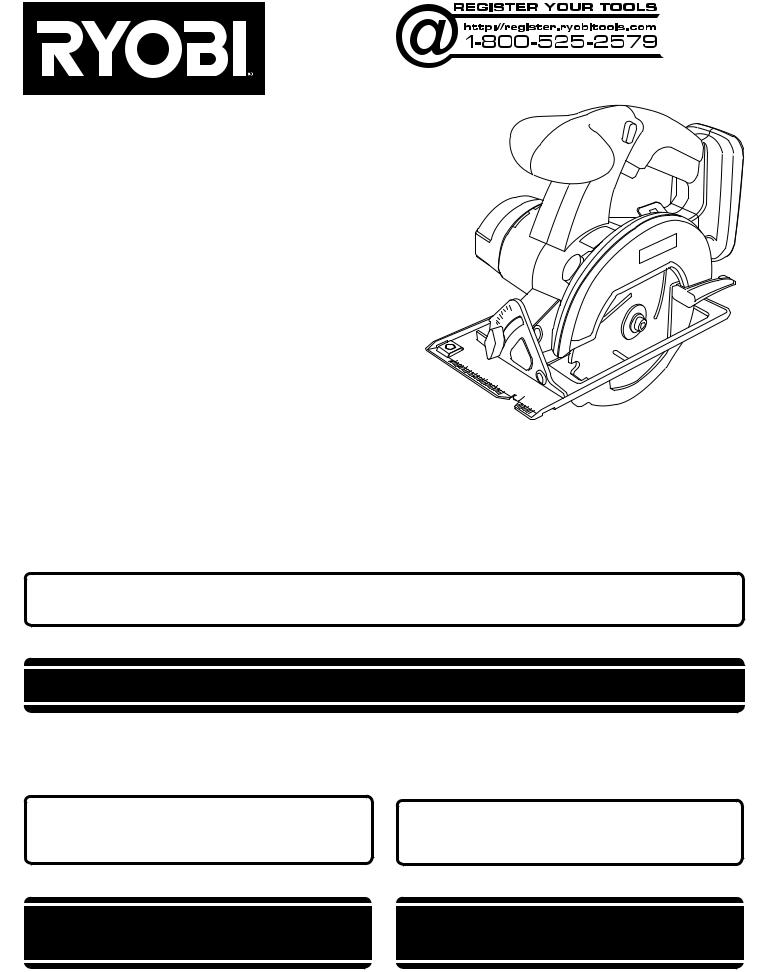
OPERATOR’S MANUAL
MANUEL D’UTILISATION
MANUAL DEL OPERADOR
5-1/2 in. 18 VOLT CIRCULAR SAW
SCIE CIRCULAIRE DE 140 mm (5-1/2 po) 18 V SIERRA CIRCULAR DE 140 mm (5-1/2 pulg.)18 V
P501G
ACCEPTS ALL ONE+ BATTERY PACKS
COMPATIBLE AVEC TOUS LE PILES ONE+
ACEPTA TODOS LOS PAQUETES DE BATERÍAS ONE+
BATTERIES AND CHARGERS SOLD SEPARATELY
PILES ET CHARGEURS VENDUS SÉPARÉMENT
LAS BATERÍAS Y CARGADORES SE VENDEN POR SEPARADO
Your saw has been engineered and manufactured to our high standard for dependability, ease of operation, and operator safety. When properly cared for, it will give you years of rugged, trouble-free performance.
 WARNING: To reduce the risk of injury, the user must read and understand the operator’s manual before using this product.
WARNING: To reduce the risk of injury, the user must read and understand the operator’s manual before using this product.
Thank you for your purchase.
SAVE THIS MANUAL FOR FUTURE REFERENCE
Cette scie circulaire a été conçu et fabriqué conformément à nos strictes normes de fiabilité, simplicité d’emploi et sécurité d’utilisation. Correctement entretenu, cet outil vous donnera des années de fonctionnement robuste et sans problème.
 AVERTISSEMENT : Pour réduire les risques de blessures, l’utilisateur doit lire et veiller à bien comprendre le manuel d’utilisation avant d’employer ce produit.
AVERTISSEMENT : Pour réduire les risques de blessures, l’utilisateur doit lire et veiller à bien comprendre le manuel d’utilisation avant d’employer ce produit.
Merci de votre achat.
Su sierra circular ha sido diseñado y fabricado de conformidad con nuestras estrictas normas para brindar fiabilidad, facilidad de uso y seguridad para el operador. Con el debido cuidado, le brindará muchos años de sólido funcionamiento y sin problemas.
 ADVERTENCIA: Para reducir el riesgo de lesiones, el usuario debe leer y comprender el manual del operador antes de usar este producto.
ADVERTENCIA: Para reducir el riesgo de lesiones, el usuario debe leer y comprender el manual del operador antes de usar este producto.
Le agradecemos su compra.
CONSERVER CE MANUEL POUR |
GUARDE ESTE MANUAL PARA |
FUTURE RÉFÉRENCE |
FUTURAS CONSULTAS |

TABLE OF CONTENTS |
|
Introduction...................................................................................................................................................................... |
2 |
Warranty........................................................................................................................................................................... |
2 |
General Power Tool Safety Warnings............................................................................................................................ |
3-4 |
Circular Saw Safety Warnings....................................................................................................................................... |
4-5 |
Symbols........................................................................................................................................................................... |
6 |
Features........................................................................................................................................................................... |
7 |
Assembly....................................................................................................................................................................... |
7-8 |
Operation.................................................................................................................................................................... |
8-12 |
Adjustments................................................................................................................................................................... |
13 |
Maintenance................................................................................................................................................................... |
13 |
Accessories.................................................................................................................................................................... |
13 |
Figure Numbers (illustrations).................................................................................................................................... |
15-17 |
Parts Ordering / Service.................................................................................................................................... |
Back Page |
INTRODUCTION
This tool has many features for making its use more pleasant and enjoyable. Safety, performance, and dependability have been given top priority in the design of this product making it easy to maintain and operate.
WARRANTY
RYOBI® POWER TOOL - LIMITED THREE YEAR WARRANTY AND 90 DAY EXCHANGE POLICY
One World Technologies, Inc., warrants its RYOBI® power tools with the following conditions:
90-DAY EXCHANGE POLICY: During the first 90 days after date of purchase, you may either request service under this warranty or you may exchange any RYOBI® power tool which does not work properly due to defective workmanship or materials by returning the power tool to the dealer from which it was purchased. To receive a replacement power tool or requested warranty service, you must present proof of purchase and return all original equipment packaged with the original product. The replacement power tool will be covered by the limited warranty for the balance of the three year period from the date of the original purchase.
WHAT THIS WARRANTY COVERS: This warranty covers all defects in workmanship or materials in your RYOBI® power tool for a period of three years from the date of purchase. With the exception of batteries, power tool accessories are warranted for ninety (90) days. Batteries are warranted for three years.
HOW TO GET SERVICE: Just return the power tool, properly packaged and postage prepaid, to an Authorized Service Center. You can obtain the location of the Service Center nearest you by contacting a service representative at One World Technologies, Inc., P.O. Box 1207, Anderson, SC 29622-1207, by calling 1-800-525-2579 or by logging on to www.ryobitools.com. When you request warranty service, you must also present proof of purchase documentation, which includes the date of purchase (for example, a bill of sale). We will repair any faulty workmanship, and either repair or replace any defective part, at our option. We will do so without any charge to you. We will complete the work in a reasonable time, but, in any case, within ninety (90) days or less.
WHAT’S NOT COVERED: This warranty applies only to the original purchaser at retail and may not be transferred. This warranty only covers defects arising under normal usage and does not cover any malfunction, failure or defects resulting from misuse, abuse, neglect, alteration, modification or repairs by other than Authorized Service Centers. One World Technologies, Inc. makes no warranties, representations or promises as to the quality or performance of its power tools other than those specifically stated in this warranty.
ADDITIONAL LIMITATIONS: Any implied warranties granted under state law, including warranties of merchantability or fitness for a particular purpose, are limited to three years from the date of purchase. One World Technologies, Inc. is not responsible for direct, indirect, or incidental damages, so the above limitations and exclusions may not apply to you. This warranty gives you specific legal rights, and you may also have other rights which vary from state to state.
2 — English

GENERAL POWER TOOL SAFETY WARNINGS
 WARNING:
WARNING:
Read all safety warnings and all instructions. Failure to follow the warnings and instructions may result in electric shock, fire and/or serious injury.
Save all warnings and instructions for future reference.
The term “power tool” in the warnings refers to your mainsoperated (corded) power tool or battery-operated (cordless) power tool.
WORK AREA SAFETY
Keep work area clean and well lit. Cluttered or dark areas invite accidents.
Do not operate power tools in explosive atmospheres, such as in the presence of flammable liquids, gases, or dust. Power tools create sparks which may ignite the dust or fumes.
Keep children and bystanders away while operating a power tool. Distractions can cause you to lose control.
ELECTRICAL SAFETY
Power tool plugs must match the outlet. Never modify the plug in any way. Do not use any adapter plugs with earthed (grounded) power tools. Unmodified plugs and matching outlets will reduce risk of electric shock.
Avoid body contact with earthed or grounded surfaces such as pipes, radiators, ranges and refrigerators.
There is an increased risk of electric shock if your body is earthed or grounded.
Do not expose power tools to rain or wet conditions.
Water entering a power tool will increase the risk of electric shock.
Do not abuse the cord. Never use the cord for carrying, pulling or unplugging the power tool. Keep cord away from heat, oil, sharp edges, or moving parts. Damaged or entangled cords increase the risk of electric shock.
When operating a power tool outdoors, use an extension cord suitable for outdoor use. Use of a cord suitable for outdoor use reduces the risk of electric shock.
If operating a power tool in a damp location is unavoidable, use a ground fault circuit interrupter (GFCI) protected supply. Use of a GFCI reduces the risk of electric shock.
Use battery only with charger listed. For use with 18V nickel-cadmium and 18V lithium-ion battery packs, see tool/appliance/battery pack/charger correlation supplement 987000-432.
PERSONAL SAFETY
Stay alert, watch what you are doing and use common sense when operating a power tool. Do not use a power tool while you are tired or under the influence of drugs, alcohol or medication. A moment of inattention while operating power tools may result in serious personal injury.
Use personal protective equipment. Always wear eye protection. Protective equipment such as dust mask, nonskid safety shoes, hard hat, or hearing protection used for appropriate conditions will reduce personal injuries.
Prevent unintentional starting. Ensure the switch is in the off-position before connecting to power source and/or battery pack, picking up or carrying the tool.
Carrying power tools with your finger on the switch or energising power tools that have the switch on invites accidents.
Remove any adjusting key or wrench before turning the power tool on. A wrench or a key left attached to a rotating part of the power tool may result in personal injury.
Do not overreach. Keep proper footing and balance at all times. This enables better control of the power tool in unexpected situations.
Dress properly. Do not wear loose clothing or jewellery. Keep your hair, clothing and gloves away from moving parts. Loose clothes, jewellery or long hair can be caught in moving parts.
If devices are provided for the connection of dust extraction and collection facilities, ensure these are connected and properly used. Use of dust collection can reduce dust-related hazards.
Do not wear loose clothing or jewelry. Contain long hair.
Looseclothes,jewelry,orlonghaircanbedrawnintoairvents.
Do not use on a ladder or unstable support. Stable footing on a solid surface enables better control of the power tool in unexpected situations.
POWER TOOL USE AND CARE
Do not force the power tool. Use the correct power tool for your application. The correct power tool will do the job better and safer at the rate for which it was designed.
Do not use the power tool if the switch does not turn it on and off. Any power tool that cannot be controlled with the switch is dangerous and must be repaired.
Disconnect the plug from the power source and/or the battery pack from the power tool before making any adjustments, changing accessories, or storing power tools. Such preventive safety measures reduce the risk of starting the power tool accidentally.
Store idle power tools out of the reach of children and do not allow persons unfamiliar with the power tool or these instructions to operate the power tool. Power tools are dangerous in the hands of untrained users.
Maintain power tools. Check for misalignment or binding of moving parts, breakage of parts and any other condition that may affect the power tool’s operation. If damaged, have the power tool repaired before use. Many accidents are caused by poorly maintained power tools.
Keep cutting tools sharp and clean. Properly maintained cutting tools with sharp cutting edges are less likely to bind and are easier to control.
3 — English

GENERAL POWER TOOL SAFETY WARNINGS
Use the power tool, accessories and tool bits etc. in accordance with these instructions, taking into account the working conditions and the work to be performed. Use of the power tool for operations different from those intended could result in a hazardous situation.
BATTERY TOOL USE AND CARE
Recharge only with the charger specified by the manufacturer. A charger that is suitable for one type of battery pack may create a risk of fire when used with another battery pack.
Use power tools only with specifically designated battery packs. Use of any other battery packs may create a risk of injury and fire.
When battery pack is not in use, keep it away from other metal objects, like paper clips, coins, keys, nails, screws or other small metal objects, that can make a
connection from one terminal to another. Shorting the battery terminals together may cause burns or a fire.
Under abusive conditions, liquid may be ejected from the battery; avoid contact. If contact accidentally occurs, flush with water. If liquid contacts eyes, additionally seek medical help. Liquid ejected from the battery may cause irritation or burns.
SERVICE
Have your power tool serviced by a qualified repair person using only identical replacement parts. This will ensure that the safety of the power tool is maintained.
When servicing a power tool, use only identical replacement parts. Follow instructions in the Maintenance section of this manual. Use of unauthorized parts or failure to follow Maintenance instructions may create a risk of shock or injury.
CIRCULAR SAW SAFETY WARNINGS
 DANGER:
DANGER:
Keep hands away from cutting area and the blade. Keep your second hand on auxiliary handle, or motor housing. If both hands are holding the saw, they cannot be cut by the blade.
Do not reach underneath the workpiece. The guard can not protect you from the blade below the workpiece.
Adjust the cutting depth to the thickness of the workpiece. Less than a full tooth of the blade teeth should be visible below the workpiece.
Never hold piece being cut in your hands or across your leg. Secure the workpiece to a stable platform.
It is important to support the work properly to minimize body exposure, blade binding, or loss of control.
Hold power tool by insulated gripping surfaces, when performing an operation where the cutting tool may contact hidden wiring. Contact with a “live” wire will also make exposed metal parts of the power tool “live” and shock the operator.
When ripping always use a rip fence or straight edge guide. This improves the accuracy of cut and reduces the chance of blade binding.
Always use blades with correct size and shape (diamond versus round) of arbour holes. Blades that do not match the mounting hardware of the saw will run eccentrically, causing loss of control.
Never use damaged or incorrect blade washers or bolt. The blade washers and bolt were specially designed for your saw, for optimum performance and safety of operation.
Do not use abrasive wheels with this tool. Doing so could cause damage the tool and/or may cause serious personal injury.
CAUSES AND OPERATOR PREVENTION OF KICKBACK:
Kickback is a sudden reaction to a pinched, bound, or misaligned saw blade, causing an uncontrolled saw to lift up and out of the workpiece toward the operator.
When the blade is pinched or bound tightly by the kerf closing down, the blade stalls and the motor reaction drives the unit rapidly back toward the operator.
If the blade becomes twisted or misaligned in the cut, the teeth at the back edge of the blade can dig into the top surface of the wood causing the blade to climb out of the kerf and jump back toward the operator.
Kickback is the result of saw misuse and/or incorrect operating procedures or conditions and can be avoided by taking proper precautions as given below:
Maintain a firm grip with both hands on the saw and position your arms to resist kickback forces. Position your body to either side of the blade, but not in line with the blade. Kickback could cause the saw to jump backwards, but kickback forces can be controlled by the operator, if proper precautions are taken.
When blade is binding, or when interrupting a cut for any reason, release the trigger and hold the saw motionless in the material until the blade comes to a complete stop. Never attempt to remove the saw from the work or pull the saw backward while the blade is in motion or kickback may occur. Investigate and take corrective actions to eliminate the cause of blade binding.
4 — English

CIRCULAR SAW SAFETY WARNINGS
When restarting a saw in the workpiece, centre the saw blade in the kerf and check that saw teeth are not engaged into the material. If saw blade is binding, it may walk up or kickback from the workpiece as the saw is restarted.
Support large panels to minimise the risk of blade pinching and kickback. Large panels tend to sag under their own weight. Supports must be placed under the panel on both sides, near the line of cut and near the edge of the panel.
Do not use dull or damaged blades. Unsharpened or improperly set blades produce narrow kerf causing excessive friction, blade binding and kickback.
Blade depth and bevel adjusting locking levers must be tight and secure before making cut. If blade adjustment shifts while cutting, it may cause binding and kickback.
Use extra caution when making a “plunge cut” into existing walls or other blind areas. The protruding blade may cut objects that can cause kickback.
ADDITIONAL SAFETY RULES
Hold power tools by insulated gripping surfaces when performing an operation where the cutting tool may contact hidden wiring or its own cord. Contact with a “live” wire will make exposed metal parts of the tool “live” and shock the operator.
Know your power tool. Read operator’s manual carefully. Learn its applications and limitations, as well as the specific potential hazards related to this tool.
Following this rule will reduce the risk of electric shock, fire, or serious injury.
Always wear eye protection with side shields marked to comply with ANSI Z87.1. Failure to do so could result in objects being thrown into your eyes, resulting in possilbe serious injury.
Protect your lungs. Wear a face or dust mask if the operation is dusty. Following this rule will reduce the risk of serious personal injury.
Protect your hearing. Wear hearing protection during extended periods of operation. Following this rule will reduce the risk of serious personal injury.
Inspect tool cords periodically and, if damaged, have repaired at your nearest authorized service center. Constantly stay aware of cord location. Following this rule will reduce the risk of electric shock or fire.
Check damaged parts. Before further use of the tool, a guard or other part that is damaged should be carefully checked to determine that it will operate properly and perform its intended function. Check for alignment of moving parts, binding of moving parts, breakage of parts, mounting, and any other conditions that may affect its operation. A guard or other part that is damaged should be properly repaired or replaced by an authorized service center. Following this rule will reduce the risk of shock, fire, or serious injury.
Do not wear loose clothing or jewellery. Contain long hair. Loose clothes, jewellery, or long hair can be drawn into air vents.
Do not use on a ladder or unstable support. Stable footing on a solid surface enables better control of the tool in unexpected situations.
Save these instructions. Refer to them frequently and use them to instruct others who may use this tool. If you loan someone this tool, loan them these instructions also.
5 — English

SYMBOLS
The following signal words and meanings are intended to explain the levels of risk associated with this product.
SYMBOL |
SIGNAL |
MEANING |
|
|
|
|
DANGER: |
Indicates an imminently hazardous situation, which, if not avoided, will result |
|
in death or serious injury. |
|
|
|
|
|
|
|
|
WARNING: |
Indicates a potentially hazardous situation, which, if not avoided, could result |
|
in death or serious injury. |
|
|
|
|
|
|
|
|
CAUTION: |
Indicates a potentially hazardous situation, which, if not avoided, may result in |
|
minor or moderate injury. |
|
|
|
|
|
|
|
|
CAUTION: |
(Without Safety Alert Symbol) Indicates a situation that may result in property |
|
damage. |
|
|
|
Some of the following symbols may be used on this product. Please study them and learn their meaning. Proper interpretation of these symbols will allow you to operate the product better and safer.
SYMBOL |
NAME |
DESIGNATION/EXPLANATION |
|
Safety Alert |
Indicates a potential personal injury hazard. |
|
Read Operator’s |
To reduce the risk of injury, user must read and understand operator’s |
|
Manual |
manual before using this product. |
|
Eye Protection |
Always wear eye protection with side shields marked to comply |
|
with ANSI Z87.1. |
|
|
|
|
|
Wet Conditions Alert |
Do not expose to rain or use in damp locations. |
|
No Hands Symbol |
Failure to keep your hands away from the blade will result in serious |
|
personal injury. |
|
|
|
|
|
|
This product uses nickel-cadmium (Ni-Cd) and lithium-ion (Li-ion) |
|
Recycle Symbols |
batteries. Local, state or federal laws may prohibit disposal of batteries |
|
in ordinary trash. Consult your local waste authority for information |
|
|
|
|
|
|
regarding available recycling and/or disposal options. |
|
Direct Current |
Type or a characteristic of current |
no |
No Load Speed |
Rotational speed, at no load |
.../min |
Per Minute |
Revolutions, strokes, surface speed, orbits etc., per minute |
V |
Volts |
Voltage |
A |
Amperes |
Current |
Hz |
Hertz |
Frequency (cycles per second) |
min |
Minutes |
Time |
6 — English
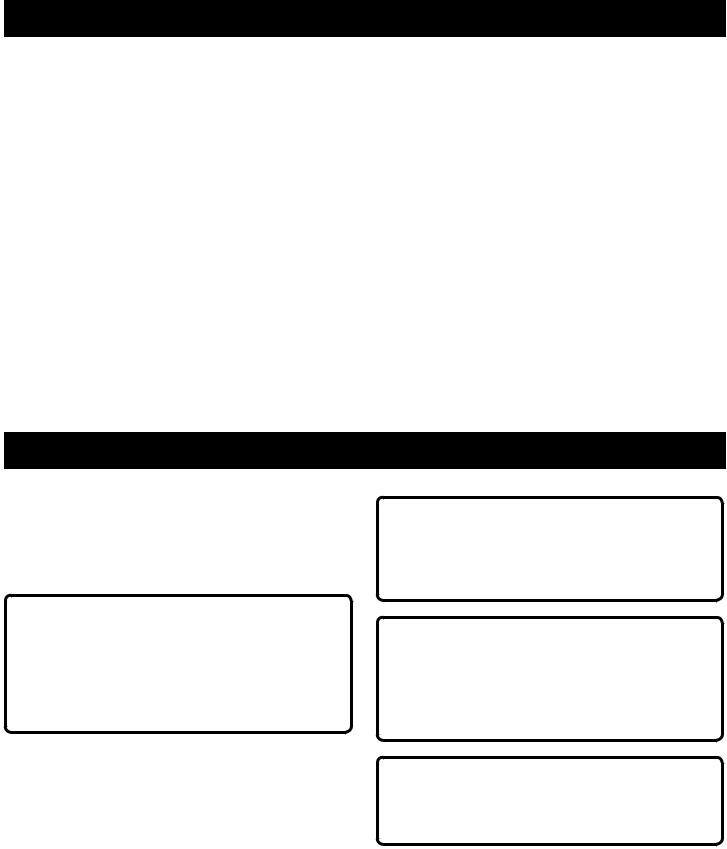
FEATURES
PRODUCT SPECIFICATIONS
Motor................................................................... |
18 Volt DC |
Blade Diameter...................................................... |
5-1/2 in. |
Blade Arbor............................................................... |
10 mm |
KNOW YOUR CIRCULAR SAW
See Figure 1, page 15.
The safe use of this product requires an understanding of the information on the tool and in this operator’s manual as well as a knowledge of the project you are attempting. Before use of this product, familiarize yourself with all operating features and safety rules.
BLADE WRENCH STORAGE
Convenient wrench storage for quick blade changes.
BEVEL ADJUSTMENT KNOB
The bevel adjustment feature allows you to make bevel cuts from 0º to 50º.
Cutting Depth at 0°.............................................. |
1-9/16 in. |
Cutting Depth at 45°.............................................. |
1-1/8 in. |
No Load Speed...................................... |
4,400 r/min. (RPM) |
LOCK-OFF BUTTON
The lock-off button reduces the possibility of accidental starting.
SPINDLE LOCK
The spindle lock allows you to secure the blade when turning the blade screw.
SWITCH TRIGGER
The saw has a conveniently located switch trigger on the underside of the handle.
WIDTH OF CUT SCALE
When making straight cross cuts or rip cuts, the scale can be used to measure up to four inches to the right side of the blade. It can be used to measure up to one inch to the left side of the blade.
ASSEMBLY
UNPACKING
This product requires assembly.
nCarefully remove the tool and any accessories from the box. Make sure that all items listed in the packing list are included.
 WARNING:
WARNING:
Do not use this product if any parts on the Packing List are already assembled to your product when you unpack it. Parts on this list are not assembled to the product by the manufacturer and require customer installation. Use of a product that may have been improperly assembled could result in serious personal injury.
nInspect the tool carefully to make sure no breakage or damage occurred during shipping.
nDo not discard the packing material until you have carefully inspected and satisfactorily operated the tool.
nIf any parts are damaged or missing, please call 1-800-525-2579 for assistance.
 WARNING:
WARNING:
If any parts are damaged or missing do not operate this product until the parts are replaced. Use of this product with damaged or missing parts could result in serious personal injury.
 WARNING:
WARNING:
Do not attempt to modify this tool or create accessories not recommended for use with this tool. Any such alteration or modification is misuse and could result in a hazardous condition leading to possible serious personal injury.
 WARNING:
WARNING:
To prevent accidental starting that could cause serious personal injury, always remove the battery pack from the product when assembling parts.
PACKING LIST
Circular Saw 5-1/2 in. Blade Blade Wrench Operator’s Manual
7 — English
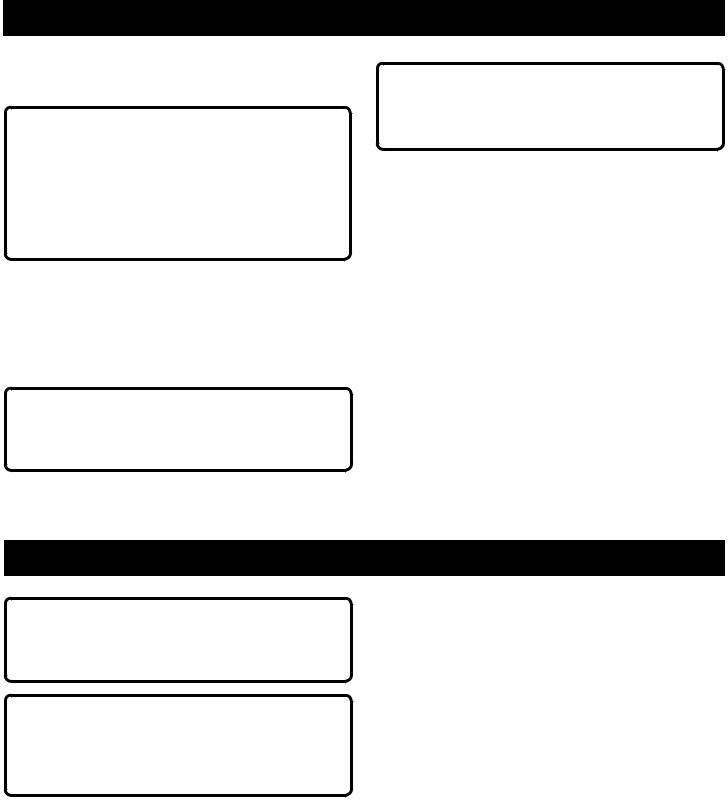
ASSEMBLY
ATTACHING THE BLADE
See Figure 2, page 15.
 WARNING:
WARNING:
A 5-1/2 in. blade is the maximum blade capacity of the saw. Never use a blade that is too thick to allow outer blade washer to engage with the flats on the spindle. Larger blades will come in contact with the blade guard, while thicker blades will prevent blade screw from securing blade on spindle. Either of these situations could result in a serious accident.
Remove the battery pack from the saw.
nRemove the blade wrench (5 mm hex key) from the storage area.
nDepress the spindle lock button and remove the blade screw and outer blade washer.
NOTE: Turn the blade screw clockwise to remove.
CAUTION:
To prevent damage to the spindle or spindle lock, always allow motor to come to a complete stop before engaging spindle lock.
NOTE: Do not run the circular saw with spindle lock engaged.
nWipe a drop of oil onto the inner blade washer and outer blade washer where they contact the blade.
 WARNING:
WARNING:
If inner blade washer has been removed, replace it before placing blade on spindle. Failure to do so could cause an
accident since blade will not tighten properly.
nFit the saw blade inside the lower blade guard and onto the spindle.
NOTE: The saw teeth point upward at the front of the saw.
nReplace the outer blade washer.
nDepress the spindle lock button, then replace the blade screw. Tighten the blade screw securely by turning it counterclockwise.
nReturn the blade wrench to the storage area.
NOTE: Never use a blade that is too thick to allow the outer blade washer to engage with the flats on the spindle.
REMOVING THE BLADE
See Figure 3, page 15.
Remove the battery pack from the saw.
nRemove the blade wrench from the storage area.
nPosition the saw as shown, depress the spindle lock button, and remove the blade screw by turning it clockwise.
nRemove the outer blade washer.
nRemove the blade.
OPERATION
 WARNING:
WARNING:
Do not allow familiarity with tools to make you careless. Remember that a careless fraction of a second is sufficient to inflict serious injury.
 WARNING:
WARNING:
Always wear eye protection with side shields marked to comply with ANSI Z87.1. Failure to do so could result in objects being thrown into your eyes resulting in possible serious injury.
APPLICATIONS
You may use this tool for the following purposes:
Cutting all types of wood products (lumber, plywood, paneling)
Cross Cutting/Rip Cutting
Bevel Cutting
Pocket Cutting
NOTE: The use of abrasive cut-off wheels is not recommended for this saw.
This product will accept Ryobi One+ 18 V lithium-ion battery packs and Ryobi One+ 18 V nickel-cadmium battery packs.
For complete charging instructions, refer to the Operator’s ManualsforyourRyobiOne+batterypackandchargermodels.
BATTERY PROTECTION FEATURES
Ryobi lithium-ion batteries are designed with features that protect the lithium-ion cells and maximize battery life.
If the tool stops during use, release the trigger to reset and resume operation. If the tool still does not work, the battery needs to be recharged.
INSTALLING THE BATTERY PACK
See Figure 4, page 15.
nPlace the battery pack in the saw. Align the raised rib on the battery pack with the groove inside the saw, then slide the battery pack into the saw.
nMake sure the latches on each side of your battery pack snap into place and the battery pack is secured in the saw before beginning operation.
8 — English

OPERATION
 WARNING:
WARNING:
Always remove battery pack from your tool when you are assembling parts, making adjustments, cleaning, or when not in use. Removing battery pack will prevent accidental starting that could cause serious personal injury.
REMOVING THE BATTERY PACK
See Figure 4, page 15.
nLocate the latches on the side of the battery pack and depress them to release the battery pack from the saw.
nRemove battery pack from the saw.
 WARNING:
WARNING:
Battery tools are always in operating condition. Therefore, switch should always be locked when not in use or carrying at your side.
KICKBACK
See Figures 5 - 8, pages 15 - 16.
Kickback occurs when the blade stalls rapidly and the saw is driven back towards you. Blade stalling is caused by any action which pinches the blade in the wood.
 DANGER:
DANGER:
Release switch immediately if blade binds or saw stalls. Kickback could cause you to lose control of the saw. Loss of control can lead to serious injury.
To guard against kickback, avoid dangerous practices such as the following:
Setting blade depth incorrectly.
Sawing into knots or nails in workpiece.
Twisting the blade while making a cut.
Making a cut with a dull, gummed up, or improperly set blade.
Supporting the workpiece incorrectly.
Forcing a cut.
Cutting warped or wet lumber.
Operating the tool incorrectly or misusing the tool.
To lessen the chance of kickback, follow these safety practices:
Keep the blade at the correct depth setting. The depth setting should not exceed 1/4 in. below the material being cut.
Inspect the workpiece for knots or nails before cutting. Never saw into a knot or nail.
Make straight cuts. Always use a straight edge guide when rip cutting. This helps prevent twisting the blade.
Use clean, sharp, and properly set blades. Never make cuts with dull blades.
Support the workpiece properly before beginning a cut.
Use steady, even pressure when making a cut. Never force a cut.
Do not cut warped or wet lumber.
Hold the saw firmly with both hands and keep your body in a balanced position so as to resist the forces if kickback should occur.
 WARNING:
WARNING:
When using the saw, always stay alert and exercise control. Do not remove the saw from the workpiece while the blade is moving.
SAW BLADES
The best of saw blades will not cut efficiently if they are not kept clean, sharp, and properly set. Using a dull blade will place a heavy load on the saw and increase the danger of kickback. Keep extra blades on hand, so that sharp blades are always available.
Gum and wood pitch hardened on blades will slow the saw down. Remove saw blade from the saw and use gum and pitch remover, hot water, or kerosene to remove these accumulations. DO NOT USE GASOLINE.
BLADE GUARD SYSTEM
See Figure 9, page 16.
The lower blade guard attached to your circular saw is there for your protection and safety. Do not alter it for any reason. If it becomes damaged, do not operate the saw until you have the guard repaired or replaced. Always leave guard in operating position when using the saw.
 DANGER:
DANGER:
When sawing through work, lower blade guard does not cover blade on the underside of work. Since blade is exposed on underside of work, keep hands and fingers away from cutting area. Any part of your body coming in contact with moving blade will result in serious injury.
 CAUTION:
CAUTION:
Never use saw when guard is not operating correctly. Check the guard for correct operation before each use. The guard is operating correctly when it moves freely and readily returns to the closed position. If you drop the saw, check the lower blade guard and bumper for damage at all depth settings before reuse.
9 — English

OPERATION
STARTING/STOPPING THE SAW
See Figure 10, page 16.
To start the saw:
Depress the lock-off button.
Squeeze the switch trigger.
Always let the blade reach full speed, then guide the saw into the workpiece.
 WARNING:
WARNING:
The blade coming in contact with the workpiece before it reaches full speed could cause the saw to “kickback” towards you resulting in serious injury.
To stop the saw: Release the switch trigger.
After you release the switch trigger, allow the blade to come to a complete stop. Do not remove the saw from the workpiece while the blade is moving.
LOCK-OFF BUTTON
See Figure 10, page 16.
The lock-off button reduces the possibility of accidental starting. The lock-off button is located on the handle above the switch trigger. The lock-off button must be depressed before you pull the switch trigger. The lock resets each time the trigger is released.
NOTE: You can depress the lock-off button from either the left or right side.
ADJUSTING BLADE DEPTH
See Figure 11, page 16.
Always keep correct blade depth setting. The correct blade depth setting for all cuts should not exceed 1/4 in. below the material being cut. More blade depth will increase the chance of kickback and cause the cut to be rough. For more depth of cut accuracy, a scale is located on the upper blade guard.
Loosen the depth adjustment knob.
Determine the desired depth of cut.
Locate the depth of cut scale on the back of the upper blade guard.
Hold the base flat against the workpiece and raise or lower the saw until the indicator mark on bracket aligns with the notch on the blade guard.
Tighten the depth adjustment knob securely.
OPERATING THE SAW
See Figures 12 - 14, page 16.
It is important to understand the correct method for operating the saw. Refer to the figures in this section to learn the correct and incorrect ways for handling the saw.
 WARNING:
WARNING:
To make sawing easier and safer, always maintain proper control of the saw. Loss of control could cause an accident resulting in possible serious injury.
 DANGER:
DANGER:
When lifting the saw from the workpiece, the blade is exposed on the underside of the saw until the lower blade guard closes. Make sure the lower blade guard is closed before setting the saw down.
To make the best possible cut, follow these helpful hints:
Hold the saw firmly with both hands.
Avoid placing your hand on the workpiece while making a cut.
Support the workpiece so that the cut (kerf) is always to your side.
Support the workpiece near the cut.
Clamp the workpiece securely so that the workpiece will not move during the cut.
Always place the saw on the workpiece that is supported, not the “cut off” piece.
Place the workpiece with the “good” side down.
Draw a guideline along the desired line of cut before beginning your cut.
CROSS CUTTING/RIP CUTTING
See Figure 15, page 17.
When making a cross cut or rip cut, align the line of cut with the outer blade guide notch on the base.
Since blade thicknesses vary, always make a trial cut in scrap material along a guideline to determine how much, if any, you must offset the guideline to produce an accurate cut.
NOTE: The distance from the line of cut to the guideline is the amount you should offset the guide.
10 — English
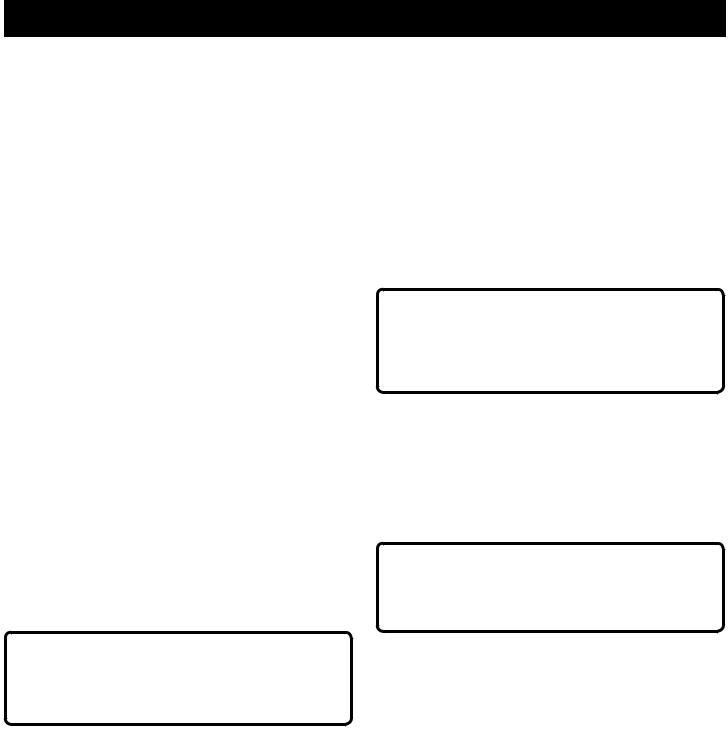
OPERATION
RIP CUTTING
See Figure 16, page 17.
Use a guide when making long or wide rip cuts with the saw.
Secure the workpiece.
Clamp a straight edge to the workpiece using C-clamps.
Saw along the straight edge to achieve a straight rip cut. NOTE: Do not bind the blade in the cut.
WIDTH OF CUT SCALE
See Figure 17, page 17.
A width of cut scale has been provided on the base of your saw. When making straight cross cuts or rip cuts, the scale can be used to measure up to four inches to the right side of the blade. It can be used to measure up to one inch to the left side of the blade.
BEVEL CUTTING
See Figures 18 - 20, page 17.
Align the line of cut with the inner blade guide notch on the base when making 45° bevel cuts.
Make a trial cut in scrap material along a guideline to determine how much you should offset the guideline on the cutting material.
Adjust the angle of the cut to any desired setting between 0º to 50º. Refer to Adjusting the Bevel Setting next.
ADJUSTING THE BEVEL SETTING
See Figure 19, page 17.
Loosen the bevel adjustment knob.
Raise the motor housing end of the saw until you reach the desired angle setting on the bevel scale.
Tighten the bevel adjustment knob securely.
 WARNING:
WARNING:
Attempting a bevel cut without having the bevel adjustment knob securely tightened can result in serious injury.
MAKING A BEVEL CUT
See Figure 20, page 17.
Hold the saw firmly with both hands as shown.
Rest the front edge of the base on the workpiece.
Start the saw and let the blade reach full speed.
Guide the saw into the workpiece and make the cut.
Release the trigger and allow the blade to come to a complete stop.
Lift the saw from the workpiece.
POCKET CUTTING
See Figure 21, page 17.
 WARNING:
WARNING:
Always adjust bevel setting to zero before making a pocket cut. Attempting a pocket cut at any other setting can result in loss of control of the saw possibly causing serious injury.
Adjust the bevel setting to zero.
Set the blade to the correct blade depth setting.
Swing the lower blade guard up using the lower blade guard handle.
NOTE: Always raise the lower blade guard with the handle to avoid serious injury.
Hold the lower blade guard by the handle.
 WARNING:
WARNING:
Never extend your fingers while holding the lower blade guard handle. Extending your fingers may result in contact with the blade, causing serious injury.
Rest the front of the base flat against the workpiece with the rear of the handle raised so the blade does not touch the workpiece.
Start the saw and let the blade reach full speed.
Guide the saw into the workpiece and make the cut.
11 — English
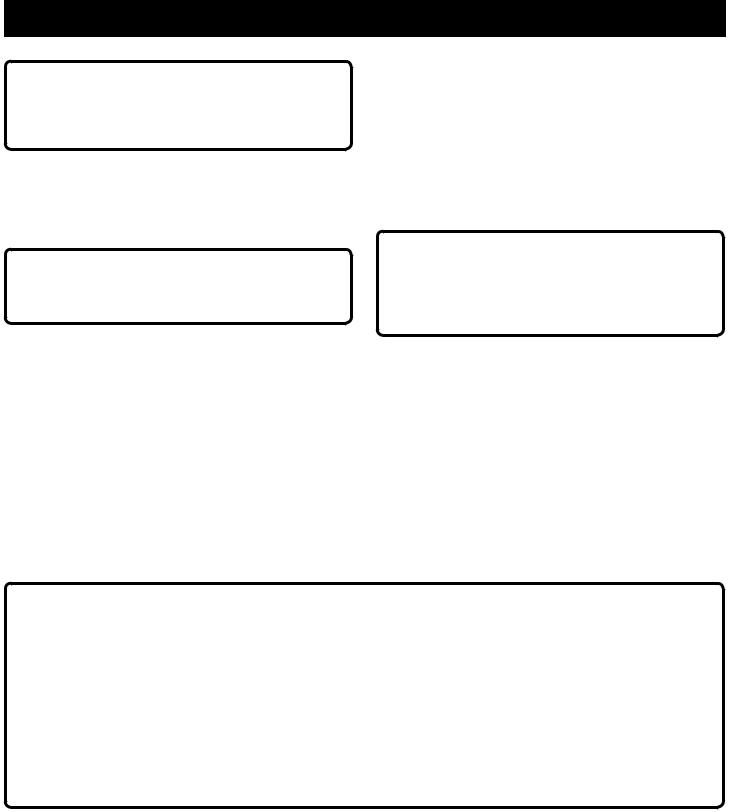
OPERATION
 WARNING:
WARNING:
Always cut in a forward direction when pocket cutting. Cutting in the reverse direction could cause the saw to climb up on the workpiece and back toward you.
Release the trigger and allow the blade to come to a complete stop.
Lift the saw from the workpiece.
Clear corners out with a hand saw or sabre saw.
 WARNING:
WARNING:
Never tie the lower blade guard in a raised position. Leaving the blade exposed could lead to serious injury.
RIP CUTTING WITH THE OPTIONAL EDGE GUIDE
See Figure 22, page 17.
Use the optional edge guide (not included), part no. 6795708 when making long or wide rip cuts with the saw.
To assemble the edge guide:
Remove the battery pack from the saw.
Place edge guide through holes in base as shown in the figure.
Adjust edge guide to the width needed.
Tighten edge guide lock knob securely.
To use edge guide:
Secure the workpiece.
Position the face of the edge guide firmly against the edge of workpiece.
Guide the saw along the edge to achieve a straight rip cut.
NOTE: The guiding edge of the workpiece must be straight for the cut to be straight. Use caution to prevent the blade from binding in the cut.
 WARNING:
WARNING:
Before performing any adjustment, make sure the battery pack is removed from tool and the switch is in the OFF position. Failure to heed this warning could result in serious personal injury.
POSITIVE 0° BEVEL STOP
See Figure 23, page 17.
The saw has a positive 0° bevel stop that has been factory adjusted to assure 0° angle of the saw blade when making 0º (right angle) cuts.
CHECKING POSITIVE 0° BEVEL STOP
Remove the battery pack from the saw.
Place the saw in an upside down position on a workbench.
Check the squareness of the saw blade to the base of the saw using a carpenter’s square.
CALIFORNIA PROPOSITION 65
 WARNING:
WARNING:
This product and some dust created by power sanding, sawing, grinding, drilling, and other construction activities may contain chemicals, including lead, known to the State of California to cause cancer, birth defects, or other reproductive harm. Wash hands after handling.
Some examples of these chemicals are:
•lead from lead-based paints,
•crystalline silica from bricks and cement and other masonry products and,
•arsenic and chromium from chemically treated lumber.
Your risk from exposure to these chemicals varies, depending on how often you do this type of work. To reduce your exposure, work in a well-ventilated area and with approved safety equipment, such as dust masks that are specially designed to filter out microscopic particles.
12 — English
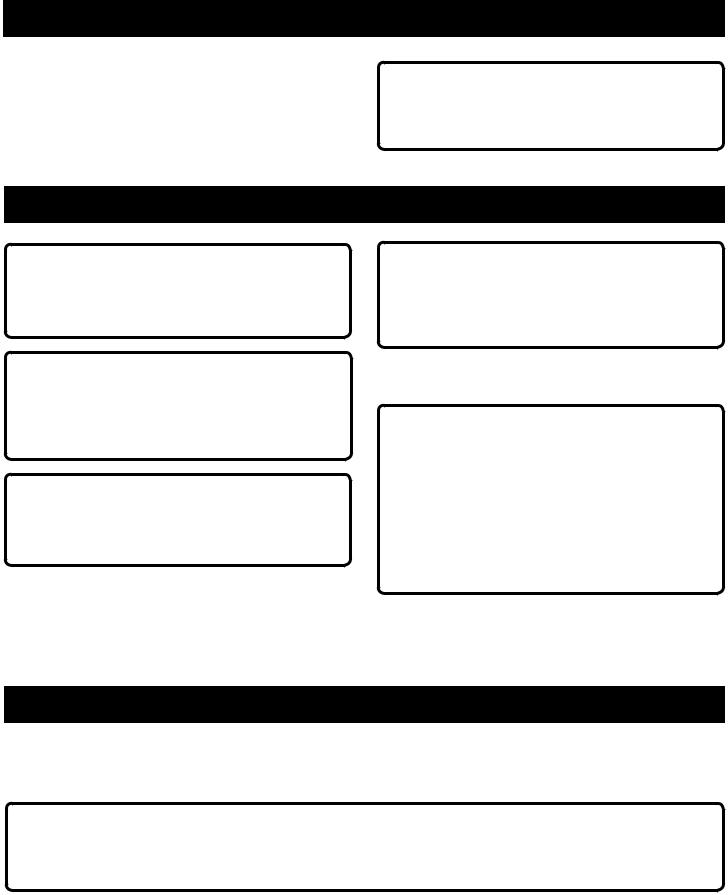
ADJUSTMENTS
ADJUSTING POSITIVE 0° BEVEL STOP
Loosen bevel adjustment knob.
Loosen hex nut securing adjusting screw.
Turn adjusting screw and adjust base until square with saw blade.
Tighten hex nut and bevel adjustment knob securely.
 WARNING:
WARNING:
Attempting a bevel cut without having the bevel adjustment knob securely tightened can result in serious injury.
MAINTENANCE
 WARNING:
WARNING:
When servicing, use only identical replacement parts. Use of any other parts may create a hazard or cause product damage.
 WARNING:
WARNING:
Do not at any time let brake fluids, gasoline, petroleumbased products, penetrating oils, etc., come in contact with plastic parts. Chemicals can damage, weaken or destroy plastic which may result in serious personal injury.
 WARNING:
WARNING:
Always wear eye protection with side shields marked to comply with ANSI Z87.1. Failure to do so could result in objects being thrown into your eyes resulting in possible serious injury.
 WARNING:
WARNING:
To avoid serious personal injury, always remove the battery pack from the tool when cleaning or performing any maintenance.
GENERAL MAINTENANCE
Avoid using solvents when cleaning plastic parts. Most plastics are susceptible to damage from various types of commercial solvents and may be damaged by their use. Use clean cloths to remove dirt, dust, oil, grease, etc.
BATTERY PACK REMOVAL AND PREPARATION FOR RECYCLING
 WARNING:
WARNING:
Upon removal, cover the battery pack’s terminals with heavy-duty adhesive tape. Do not attempt to destroy or disassemble battery pack or remove any of its components. Lithium-ion and nickel-cadmium batteries must be recycled or disposed of properly. Also, never touch both terminals with metal objects and/or body parts as short circuit may result. Keep away from children. Failure to comply with these warnings could result in fire and/or serious injury.
ACCESSORIES
Look for these accessories where you purchased this product or call 1-800-525-2579:
|
5-1/2 in. Thin Kerf Blade................................................................................................................................... |
670973029 |
|
Edge Guide Kit.................................................................................................................................................. |
201985001 |
 WARNING:
WARNING:
Current attachments and accessories available for use with this tool are listed above. Do not use any attachments or accessories not recommended by the manufacturer of this tool. The use of attachments or accessories not recommended can result in serious personal injury.
NOTE: FIGURES (ILLUSTRATIONS) START ON PAGE 15 AFTER FRENCH AND SPANISH LANGUAGE SECTIONS.
13 — English

NOTES
14 — English
